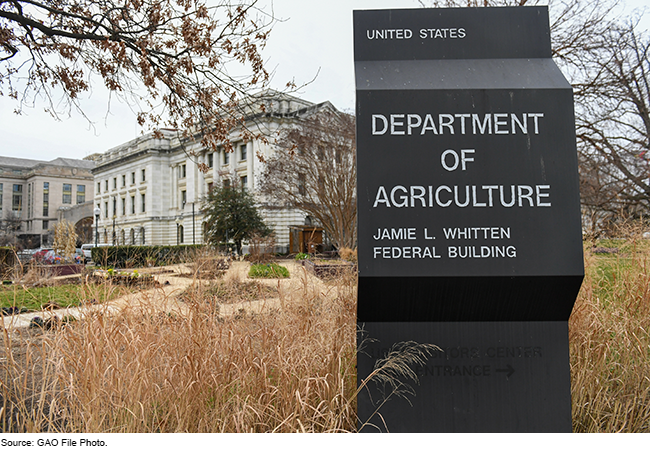Evidence-Based Policy Making: USDA's Decision to Relocate Research Agencies to Kansas City Was Not Fully Consistent with an Evidence-Based Approach
Fast Facts
In 2019, USDA moved most staff positions for 2 of its agencies—the Economic Research Service and the National Institute of Food and Agriculture—from DC to Kansas City. Its stated objectives were to improve its ability to find highly qualified staff, place resources closer to users, and reduce costs.
We reviewed the analysis that USDA used to decide where to relocate these agencies. We found that USDA overlooked key evidence, e.g., it didn't factor in potential costs related to the attrition of staff or the disruption of agencies' activities due to the relocation. As a result, USDA cannot be sure it made the best choice to meet its objectives.

Highlights
What GAO Found
An economic analysis conducted by the U.S Department of Agriculture (USDA) with assistance from Ernst and Young was critical to informing USDA leadership about potential sites for relocating the National Institute of Food and Agriculture (NIFA) and the Economic Research Service (ERS) (see figure).
Key Steps in USDA's Economic Analysis of Potential Relocation Sites

USDA's stated objectives for relocation were to improve its ability to attract and retain highly-qualified staff; place its resources closer to stakeholders and consumers; and reduce costs to taxpayers. However, GAO found that the economic analysis did not fully align with those objectives. For example, USDA used cost of living to screen out locations and then eliminated sites that did not have sufficient space to co-locate NIFA and ERS. However, some of the sites eliminated ranked highly in terms of USDA's stakeholder proximity and staff recruitment and retention objectives. In addition, USDA omitted critical costs and economic effects from its analysis of taxpayer savings, such as costs related to potential attrition or disruption of activities for a period of time, which may have contributed to an unreliable estimate of savings from relocation.
Overall, GAO found that USDA's development and usage of evidence had significant limitations. In addition to the methodological concerns highlighted above, key characteristics of a high-quality analysis were absent, including transparency around key methodological decisions and sensitivity analysis to assess the reasonableness of critical assumptions. According to Office of Management and Budget guidance on implementing the Foundations for Evidence-Based Policymaking Act of 2018, agencies should use evidence when making decisions related to agency operations. This evidence should be good quality and should be collected and analyzed in a transparent manner that involves stakeholders to maintain accountability and ensure that it is not tailored to generate specific findings. As a result of the weaknesses GAO found, USDA leadership may have made a relocation decision that was not the best choice to accomplish its stated objectives.
Why GAO Did This Study
USDA is made up of several agencies, including the research agencies, ERS and NIFA. ERS reviews trends and emerging issues in food, agriculture, the environment, and rural America, while NIFA administers federal funding through formula and competitive grants, among other things.
In October 2019, USDA relocated most staff positions at ERS and NIFA from their headquarters in Washington, D.C. to Kansas City, Missouri. This decision was based on USDA's economic analysis. USDA stated the move would save taxpayers more than $300 million over 15 years compared to remaining in the Washington, D.C. region.
GAO was asked to assess the analysis USDA used to support its decision to relocate ERS and NIFA to the Kansas City region. This report reviewed how USDA made its relocation decision, the underlying analyses, and the use of evidence in its decision-making.
GAO reviewed USDA's contracting documents and the deliverables provided by the contractor, interviewed USDA officials and contractor staff, and evaluated the economic analysis using criteria in GAO-18-151SP.
GAO is not making any recommendations at this time because, among other reasons, the relocation has already taken place and OMB has since circulated comprehensive guidance on how to build and use quality evidence that, if effectively implemented, should address the weaknesses highlighted. USDA neither agreed nor disagreed with our findings but disagreed with the criteria we used to evaluate the agency's economic analysis. We stand by our analysis as discussed in the report.
For more information, contact Lawrance L. Evans Jr. at (202) 512-4802 or EvansL@gao.gov.
